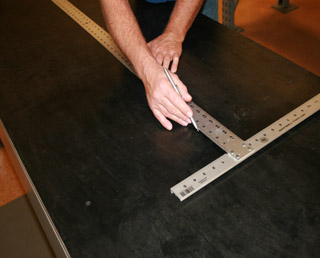Why Squaring Your Belt Is Important for Your Belt Conveyor
July 25, 2018
 Why Squaring Your Belt Is Important for Your Belt Conveyor
Why Squaring Your Belt Is Important for Your Belt Conveyor
It’s tempting to cut a few corners and skip steps along the way when splicing your belt. One step you should never skip is properly squaring the belt. Squaring your belt ends is a job that requires only a few minutes of your time, but offers real paybacks in extending the life of your belt conveyor system.
Effective belt repairs start with straight, square cuts. An accurate, squared cut will enhance belt and splice performance and ensure the belt tension is distributed evenly across the belt. But if your belt isn’t square, you could see serious problems down the belt conveyor line.
Mistracking, spillage, and belt damage
Although there are many factors that can result in a conveyor belt mistracking, one of the most common reasons is that the belt ends were not cut straight. When the splice is installed on a non-square belt, this creates uneven tension along the splice and will cause the conveyor belt to mistrack. Frayed, worn belt edges will often signal a mistracked belt – caused when the uneven tension directs the belt to scrape against the belt conveyor structure. In the most severe cases, this will result in damage to the splice itself and even splice failure.
Uneven belt tracking can also shift the material path from the center of the belt to the edge of the belt, which will result in material spilling off the belt and add clean-up work to your already overburdened maintenance team.
Belt squaring best practice
Flexco recommends the centerline method as a best practice for squaring the belt. This method involves measuring across the belt width on both belt ends at several points spaced three to five feet apart and marking the center at each point. Then, the average centerline is drawn through those points, using a long steel rule or a chalk line.
Cutting tools you can use
To square using the centerline method, you’ll need to make sure you have the proper tools, including a tape measure, chalk line or steel rule, belt marking tool, square, and belt cutter. While the utility knife is an attractive option because it is readily available and inexpensive, it can be a safety and accuracy nightmare. Working with an exposed blade always presents a safety hazard and, when this is paired with the several passes it takes to complete the cut, it increases the risk of injury.
Multiple passes with the knife also diminish the chances of a straight and accurate cut, effectively eliminating all the work you did to square the belt for cutting. Instead, use a hand-powered or electric belt cutter with an enclosed blade that makes cutting your conveyor belt faster, safer, and easier.
Squaring the conveyor belt – step by step
For a step by step guide to squaring the belt before cutting, check out our Insights on proper belt squaring here.
Authored by: Aaron Rosso, Senior Product Manager
Rosso is responsible for managing the heavy-duty mechanical belt fastener program globally for Flexco, including the program vision and strategy, product development plan, product line portfolio, promotion, PR and communications, pricing, and profitability. Rosso graduated from Western Michigan University with a bachelor’s degree in Finance and received his master’s degree in business administration from the Kellogg School of Management at Northwestern University with a concentration in Marketing and Strategy.
Subscribe to the Flexco Blog
Published Date
July 25, 2018Product Group
- Mechanical Belt Fastening Systems
Issues
- Belt Protection
- Mistracking
- Slippage
